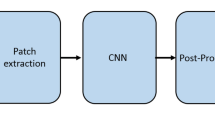Abstract
Manual segmentation of brain tumors from MRI images is very frustrating and time consuming for medical doctors and relies on accurate segmentation of regions of interests. Convolutional neural networks (CNN)–based segmentation has gained a huge amount of attention over the last few years due to its speed and automated aspect. As the CNN models are becoming more efficient for image analysis and processing, they increasingly defeat previous state-of-the-art classical machine learning algorithms. Through this study, we provide an overview of CNN-based segmentation models for quantitative brain MRI image segmentation. As this has become a fast-expanding field, we will not survey the entire existing landscape of methods, but we will focus on the three best outperforming algorithms according to evaluation parameters. First, we review the current conventional methods and deep learning architectures used for segmentation of brain lesions. Next, we perform deep performance comparison based on accuracy and loss function of some relevant selected CNN methods. Finally, a critical analysis of the current study is made to identify all pertinent issues and limitations to work on.
Access this chapter
Tax calculation will be finalised at checkout
Purchases are for personal use only
Similar content being viewed by others
References
Dubey, R. B., Hanmandlu, M., & Vasikarla, S. (2011). Evaluation of three methods for MRI brain tumor segmentation. In 2011 Eighth International Conference on Information Technology: New Generations. https://doi.org/10.1109/itng.2011.92
Liu, J., Li, M., Wang, J., Wu, F., Liu, T., & Pan, Y. (2014). A survey of MRI-based brain tumor segmentation methods. Tsinghua Science and Technology, 19(6), 578–595. https://doi.org/10.1109/tst.2014.6961028
Parihar, A. S. (2017). A study on brain tumor segmentation using convolution neural network. In 2017 International Conference on Inventive Computing and Informatics (ICICI). https://doi.org/10.1109/icici.2017.8365336
Pereira, S., Pinto, A., Alves, V., & Silva, C. A. (2016). Brain tumor segmentation using convolutional neural networks in MRI images. IEEE Transactions on Medical Imaging, 35(5), 1240–1251. https://doi.org/10.1109/tmi.2016.2538465
Nwankpa, C., Ijomah, W.L., Gachagan, A., & Marshall, S. (2018). Activation functions: Comparison of trends in practice and research for deep learning. ArXiv, abs/1811.03378.
Kamnitsas, K. et al. (2018) Ensembles of multiple models and architectures for robust brain tumour segmentation. In: Crimi, A., Bakas, S., Kuijf, H., Menze, B., & Reyes, M. (Eds.), Brain lesion: Glioma, multiple sclerosis, stroke and traumatic brain injuries. BrainLes 2017. Lecture Notes in Computer Science (vol. 10670). Cham: Springer. https://doi.org/10.1007/978-3-319-75238-9_38.
Kayalibay, B., Jensen, G., & Smagt, P.V. (2017). CNN-based segmentation of medical imaging data. ArXiv, abs/1701.03056.
Myronenko, A. (2019). 3D MRI brain tumor segmentation using autoencoder regularization. Lecture Notes in Computer Science, 311–320. https://doi.org/10.1007/978-3-030-11726-9_28
Kevin Zhou, S., Greenspan, H., & Shen, D (2018). Deep learning for medical image analysis. https://doi.org/10.4103/jpi.jpi_27_18.
Lecun, Y., Bottou, L., Bengio, Y., & Haffner, P. (1998). Gradient-based learning applied to document recognition. Proceedings of the IEEE, 86(11), 2278–2324. https://doi.org/10.1109/5.726791
Russakovsky, O., Deng, J., Su, H., Krause, J., Satheesh, S., Ma, S., … Fei-Fei, L. (2015). ImageNet large scale visual recognition challenge. International Journal of Computer Vision, 115(3), 211–252. https://doi.org/10.1007/s11263-015-0816-y
Buda, M., Saha, A., & Mazurowski, M. A. (2019). Association of genomic subtypes of lower-grade gliomas with shape features automatically extracted by a deep learning algorithm. Computers in Biology and Medicine, 109, 218–225. https://doi.org/10.1016/j.compbiomed.2019.05.002
Hinton, G.E., Srivastava, N., Krizhevsky, A., Sutskever, I., & Salakhutdinov, R. (2012). Improving neural networks by preventing co-adaptation of feature detectors. ArXiv, abs/1207.0580.
Ioffe, S., & Szegedy, C. (2015). Batch normalization: Accelerating deep network training by reducing internal covariate shift. ArXiv, abs/1502.03167.
He, K., Zhang, X., Ren, S., & Sun, J. (2016). Identity mappings in deep residual networks. Lecture Notes in Computer Science, 630–645. https://doi.org/10.1007/978-3-319-46493-0_38
Benson, E., Pound, M. P., French, A. P., Jackson, A. S., & Pridmore, T. P. (2019). Deep hourglass for brain tumor segmentation. Lecture Notes in Computer Science, 419–428. https://doi.org/10.1007/978-3-030-11726-9_37
Chen, W., Liu, B., Peng, S., Sun, J., & Qiao, X. (2019). S3D-UNet: Separable 3D U-net for brain tumor segmentation. Lecture Notes in Computer Science, 358–368. https://doi.org/10.1007/978-3-030-11726-9_32
Author information
Authors and Affiliations
Editor information
Editors and Affiliations
Rights and permissions
Copyright information
© 2022 Springer Nature Switzerland AG
About this paper
Cite this paper
Moujahid, H., Cherradi, B., Bahatti, L. (2022). Comparison Study on Some Convolutional Neural Networks for Cerebral MRI Images Segmentation. In: Elhoseny, M., Yuan, X., Krit, Sd. (eds) Distributed Sensing and Intelligent Systems. Studies in Distributed Intelligence . Springer, Cham. https://doi.org/10.1007/978-3-030-64258-7_48
Download citation
DOI: https://doi.org/10.1007/978-3-030-64258-7_48
Published:
Publisher Name: Springer, Cham
Print ISBN: 978-3-030-64257-0
Online ISBN: 978-3-030-64258-7
eBook Packages: Earth and Environmental ScienceEarth and Environmental Science (R0)




